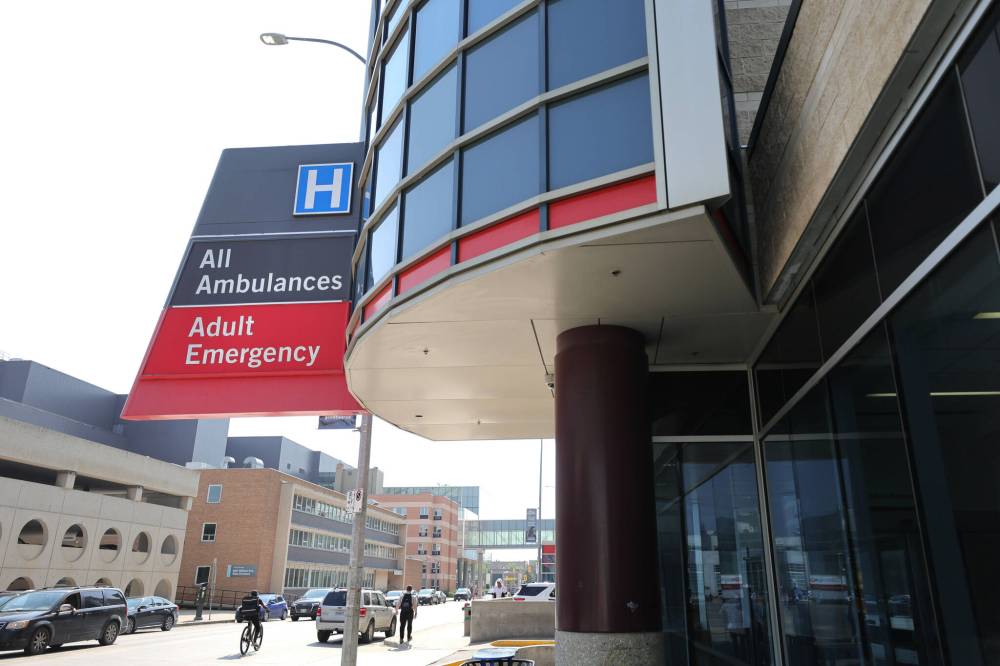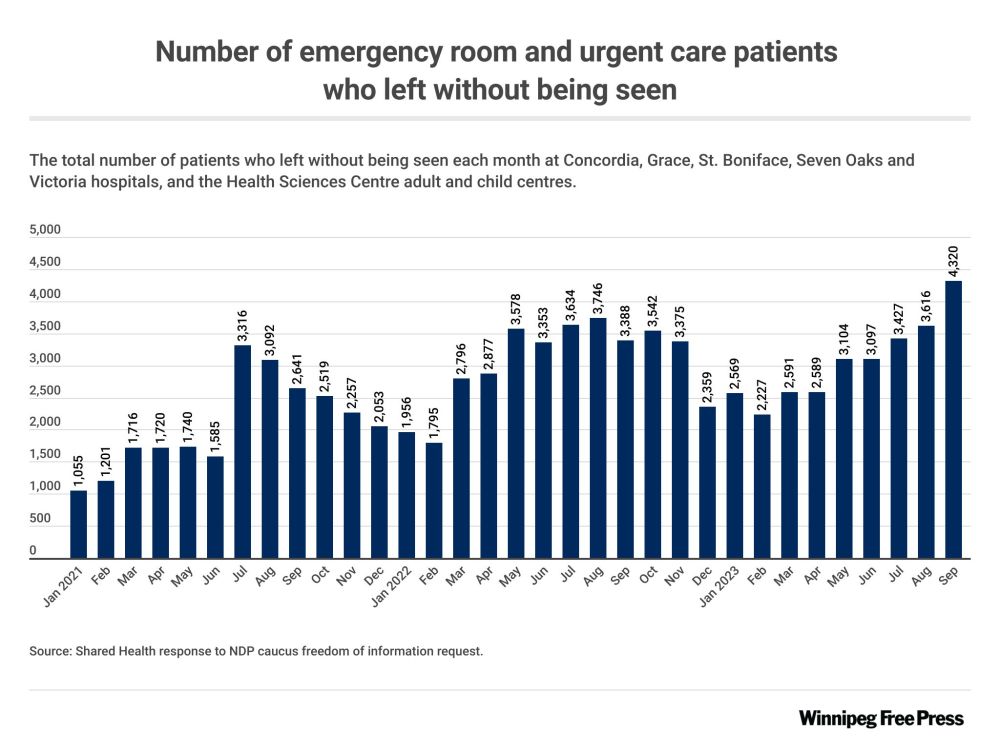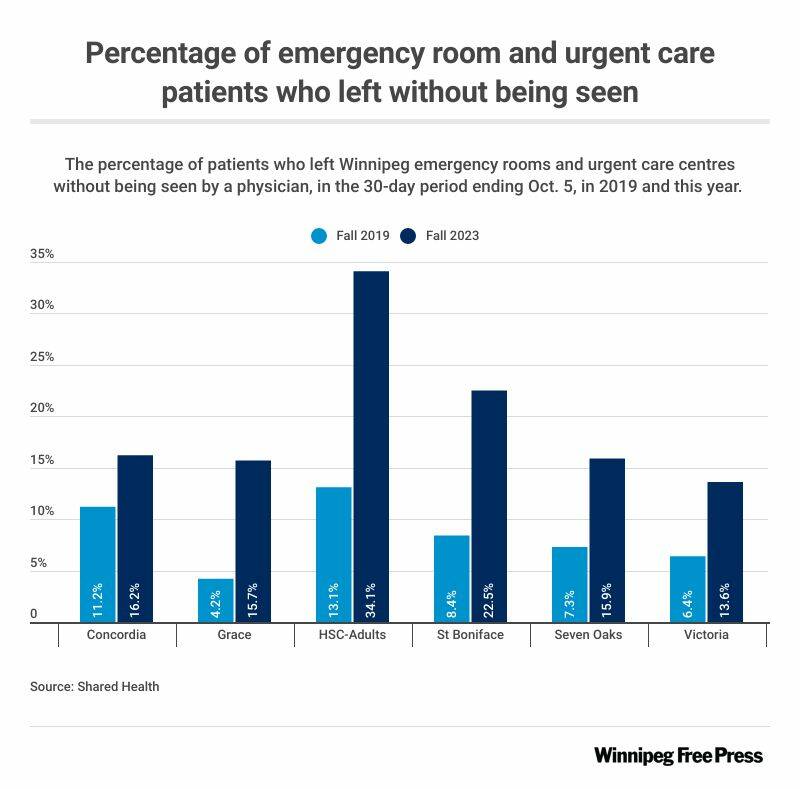Front-line staffing only way out of ER wilderness
Advertisement
Read this article for free:
or
Already have an account? Log in here »
To continue reading, please subscribe:
Monthly Digital Subscription
$0 for the first 4 weeks*
- Enjoy unlimited reading on winnipegfreepress.com
- Read the E-Edition, our digital replica newspaper
- Access News Break, our award-winning app
- Play interactive puzzles
*No charge for 4 weeks then price increases to the regular rate of $19.00 plus GST every four weeks. Offer available to new and qualified returning subscribers only. Cancel any time.
Monthly Digital Subscription
$4.75/week*
- Enjoy unlimited reading on winnipegfreepress.com
- Read the E-Edition, our digital replica newspaper
- Access News Break, our award-winning app
- Play interactive puzzles
*Billed as $19 plus GST every four weeks. Cancel any time.
To continue reading, please subscribe:
Add Free Press access to your Brandon Sun subscription for only an additional
$1 for the first 4 weeks*
*Your next subscription payment will increase by $1.00 and you will be charged $16.99 plus GST for four weeks. After four weeks, your payment will increase to $23.99 plus GST every four weeks.
Read unlimited articles for free today:
or
Already have an account? Log in here »
Hey there, time traveller!
This article was published 26/10/2023 (780 days ago), so information in it may no longer be current.
Patients in Winnipeg emergency rooms continued to pile up at record levels in September.
Despite claims of “record investments” in health care by the previous Progressive Conservative government in its final year in office, wait times last month at Winnipeg ERs and urgent care centres were the highest on record.
The main reason: not a single hospital bed was added to Winnipeg Regional Health Authority facilities over the past year.

RUTH BONNEVILLE / WINNIPEG FREE PRESS FILES
ER and urgent care wait times increased at every hospital in Winnipeg last month.
Fresh statistics released this week by the WRHA show the median wait time for patients at ERs and urgent care centres in Winnipeg hit a record 3.43 hours. Half waited longer and half shorter. That’s up from 3.12 hours in August and 3.08 hours in September 2022.
ER wait times have more than doubled since the former Tory government launched its ill-fated hospital reform plan in 2017, which included the shuttering of three Winnipeg emergency departments.
Worse, the 90th percentile wait times at ERs and urgent care centres (the longest wait time for nine out of 10 patients) soared to 9.82 hours in September. It hit a mind-boggling 13.55 hours at Health Sciences Centre, where overcrowding has been at crisis levels for well over a year. ER and urgent care wait times increased at every hospital in Winnipeg last month.
It’s a disaster.
Patients sick enough to be admitted to hospital are spending days in ER hallways because there aren’t enough staffed hospital beds on medical wards to accommodate them. That means ER doctors and nurses have less time to see new patients. So everyone waits, in pain and discomfort, unable to see a physician for hours — if at all.
The percentage of patients that left ERs and urgent care centres without seeing a doctor has more than doubled to 11 per cent in 2022-23 from just under five per cent in 2018-19.
That’s how hospitals now handle patient overflow: sick people leave because they can’t access care in a timely manner.
Some of those patients are less acute and can be treated elsewhere. Others have more complicated medical conditions that left untreated, will get worse.
Winnipeg hospitals are more congested than ever before. There isn’t enough capacity in the system to handle patient demand. When that happens, patients pile up in emergency departments while they wait, sometimes days, for a bed on a medical ward.

It’s not because of a surge in patient volumes. The number of patients presenting at ERs and urgent care centres is up 3.5 per cent since 2020-21. But volumes are down 10 per cent from 2019-20, the year before the COVID-19 pandemic began.
The problem is there are fewer staffed beds in the system.
According to the WRHA’s annual report released earlier this month, there were 2,244 staffed beds at Winnipeg facilities in 2022-23, exactly the same number as the previous year and the lowest since at least 2016-17, when there were 2,415 staffed beds.
Those figures do not include HSC, which was placed under the control of Shared Health in 2017, when the previous government added another layer of bureaucracy to the system. Shared Health has not yet released its annual report for 2022-23.
In its 2021-22 annual report, Shared Health reports a slight increase in staffed beds at HSC — to 780 from 762 — between 2017-18 and 2021-22. Still, the overall number of beds at Winnipeg hospitals is down over the past five years.
There are many reasons why admitted patients in emergency departments wait days for a medical bed. Those who work in the system call it “access block.”
Fewer staffed beds is one of the main reasons. Other factors include a shortage of personal care home beds and other alternative spaces for elderly and chronically ill patients to go once admitted to hospital. The longer they wait for a spot elsewhere, the more it contributes to access block.
All of that trickles down to emergency departments, where the bottlenecks are most visible.
Reopening more emergency rooms, as the new NDP government has pledged, will not solve the problem. Nor will opening more community clinics for low-acuity patients, also something the NDP promised.

Neither would increase capacity in the system for high-acuity patients nor provide elderly and chronically ill patients languishing in hospitals with alternative care. It will do nothing to address access block.
The only way government can begin to solve the problem is by increasing front-line staffing levels. The Kinew government has promised to do that.
The extent to which it can recruit and retain more staff will determine how well it can reduce hospital overcrowding and reduce wait times in other areas, such as surgery and diagnostic testing.
How it plans to do so is still a mystery. Manitobans await with bated breath.
tom.brodbeck@freepress.mb.ca

Tom Brodbeck is an award-winning author and columnist with over 30 years experience in print media. He joined the Free Press in 2019. Born and raised in Montreal, Tom graduated from the University of Manitoba in 1993 with a Bachelor of Arts degree in economics and commerce. Read more about Tom.
Tom provides commentary and analysis on political and related issues at the municipal, provincial and federal level. His columns are built on research and coverage of local events. The Free Press’s editing team reviews Tom’s columns before they are posted online or published in print – part of the Free Press’s tradition, since 1872, of producing reliable independent journalism. Read more about Free Press’s history and mandate, and learn how our newsroom operates.
Our newsroom depends on a growing audience of readers to power our journalism. If you are not a paid reader, please consider becoming a subscriber.
Our newsroom depends on its audience of readers to power our journalism. Thank you for your support.
History
Updated on Thursday, October 26, 2023 3:42 PM CDT: Adds charts








